Great Lakes Oil Pipeline in Violation of Operating Agreement, Groups Allege
Michigan urged to terminate Line 5 crossing in the Straits of Mackinac.
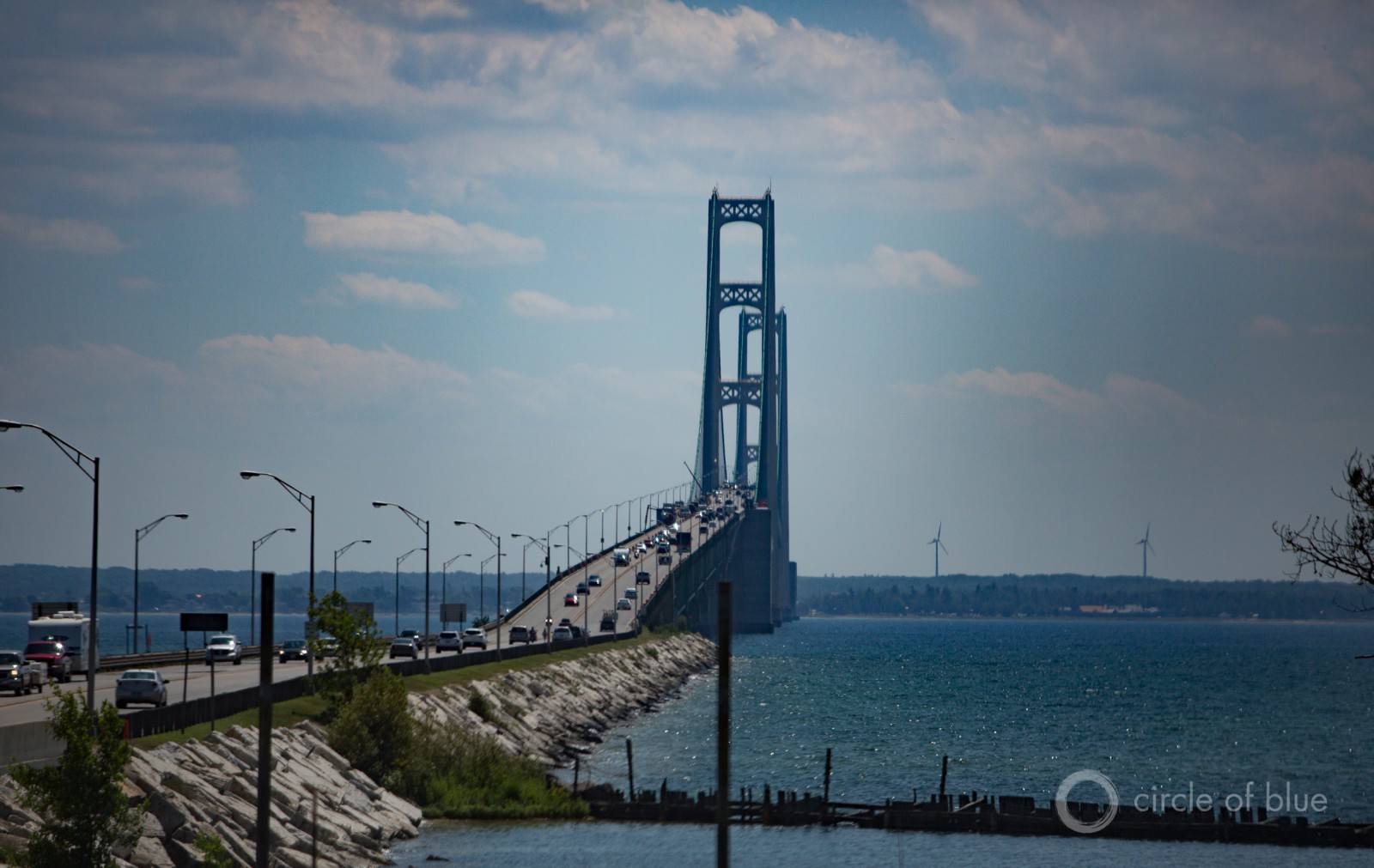
Enbridge, Inc.’s Line 5 pipeline splits in two and crosses beneath the waters of the Straits of Mackinac, near the site of Michigan’s Mackinac Bridge. Photo © J. Carl Ganter / Circle of Blue
By Codi Kozacek
Circle of Blue
Twin 63-year-old oil pipelines crossing beneath the waters that connect Lake Michigan and Lake Huron are currently out of compliance with the state agreement that allows their existence, according to a letter and memorandum sent Wednesday by 22 environmental and tribal groups to Michigan’s governor and attorney general.
The letter outlined eight violations of a 1953 easement that provides for Line 5, an oil pipeline operated by Canadian energy company Enbridge, Inc., to cross an 8-kilometer (5-mile) stretch of Great Lakes water at the Straits of Mackinac. In light of the violations, which include physical problems with the pipeline itself as well as a failure to operate the pipeline in a reasonably prudent manner, the groups called on state leaders to revoke permission for the Line 5 crossing.
Further, they asked the state to act immediately in lieu of waiting until 2017, when a state advisory board is scheduled to complete an independent risk analysis and review of alternatives to the pipeline.
“Given Enbridge’s significant easement violations and public trust obligations, we, the undersigned, believe that it is imprudent for the State of Michigan to wait over a year until the final risk and alternatives reports are slated for completion,” the letter concludes. “Therefore, we urge the State of Michigan to immediately notify Enbridge in writing that the State is terminating the 1953 Easement…on the basis of these multiple breaches of the terms and conditions of the easement and consistent with your legal trustee responsibilities to the citizens of Michigan.”
The letter outlined eight violations of a 1953 easement that provides for Line 5 to cross an 8-kilometer stretch of Great Lakes water.
Enbridge took issue with the letter’s allegations, writing in a response sent to Circle of Blue that the residents and state officials of Michigan “deserve more than scare tactics and fearmongering that only serve to create a climate of concern and uncertainty on a pipeline that has safely operated across the Straits since its installation.” It added that the state Pipeline Safety Advisory Board is already taking action to evaluate the operation of the Line 5 pipelines.
“To be clear, we are in full compliance with all state and federal regulations, and with the easement requirements for the Straits of Mackinac Crossing,” it said.
Line 5, which carries oil and natural gas products from Canada to refineries in southern Michigan and Ontario, has been the focus of intense public scrutiny since a 2012 report by the National Wildlife Federation highlighted concerns about the integrity of the aging pipelines, as well as the operating record of Enbridge, the company responsible for a 2010 oil spill into Michigan’s Kalamazoo River. That incident was the worst inland oil spill in U.S. history.
More than 30 local governments and six Native American tribes have since passed resolutions asking the state to restrict the flow of oil through Line 5 where it crosses the straits. Despite two years of state review, there is still too much that is unknown about the integrity and condition of the pipelines below the straits, according to the groups that sent the letter. In a teleconference held Wednesday morning, they also called on Enbridge to release engineering reports that definitively show the pipelines are safe.
“They need to assure us all that what they are doing is safe. They haven’t done that,” said James Tamlyn, chairman of the Board of Commissioners for Emmet County, which is immediately west of Mackinaw City. “They seem to be spending most of their money on trying to market that the line is in good shape. Instead of spending that money on marketing, they should spend that money on getting the documentation to an independent engineering review approved by the governor’s office, and I think we’ll all be happy.”
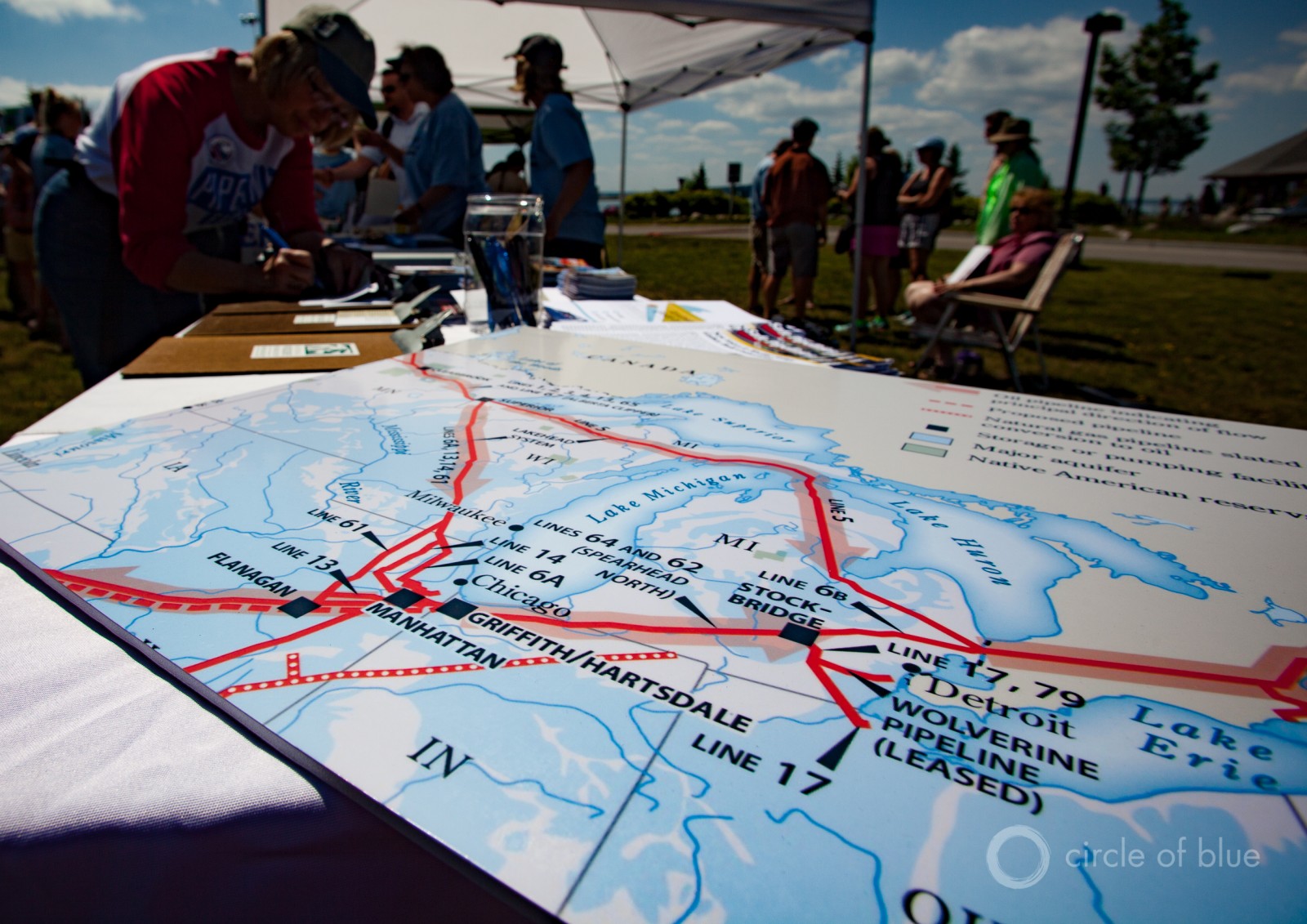
The Line 5 pipeline is part of Enbridge’s extensive Lakehead System, which transports oil and natural gas products through the Midwest and Great Lakes region. Photo © J. Carl Ganter / Circle of Blue
The stakes of a potential spill are high. A study released last month conducted by researchers at the University of Michigan and supported by the National Wildlife Federation found that more than 1,000 kilometers (621 miles) of shoreline and 44,000 square kilometers (17,000 square miles) of open water in Lake Huron and Lake Michigan are vulnerable to an oil spill from the Line 5 straits crossing. Enbridge responded that the study was based on unrealistic assumptions of the amount of oil that could spilled, did not take into account spill response actions, and only considered an oil spill, not a spill of the natural gas liquids that are also transported through the lines. Researchers have previously concluded that the Straits would be the worst possible place for an oil spill in the Great Lakes because it could quickly spread along shorelines in both lakes, affecting both Michigan and Ontario.
“Everybody understands that this is an unacceptable risk. When you look at a high risk, this is of the highest level,” Jim Olson, president of Traverse City-based water law and policy group For Love of Water (FLOW), told reporters. “It is standard Emergency Response 101 or Hazardous Materials 101—when you have a high risk and a lack of sufficient information and a lot of unknowns, you must eliminate the risk and take action immediately, even if it is temporary until you understand the situation. Anything less is imprudent.”
Cause for Action
The legal case for Michigan to shut down the transport of oil through Line 5 rests largely on a 1953 easement agreement between the state and Enbridge, which stipulated how the pipelines should be constructed and operated. The easement allows the pipelines to cross the public waters and bottomlands of the Great Lakes at the Straits of Mackinac. Revoking the easement would effectively shut down Line 5 as it is currently operated, severing the pipeline’s connection between the upper and lower peninsulas of Michigan.
However, Line 5 is part of the vast Lakehead System of pipelines that Enbridge uses to transport oil and natural gas products in the Great Lakes region. While Enbridge says Line 5 is a vital piece of infrastructure, independent studies by FLOW argue that the Line 5 straits crossing is unnecessary to maintain service to Enbridge’s customers.
To be clear, we are in full compliance with all state and federal regulations, and with the easement requirements for the Straits of Mackinac Crossing.
— Enbridge statement
While Enbridge insists it is in compliance with the 1953 agreement, the memorandum contends that the Line 5 pipelines are currently violating the terms and conditions of the easement in eight ways:
1. Failing to exercise due care. The memorandum argues that Enbridge is not fulfilling its obligation to act in the way of a “reasonably prudent person” to ensure the safety of the public and public and private property. It says Enbridge has withheld and misrepresented information “essential to evaluating the risks” of Line 5, and that simply the potential for a spill in the straits is too high a risk to be considered prudent.
In response, Enbridge cited the portion of its website dedicated to information about Line 5, which includes data and fact sheets the company has released about pipeline safety and risk reduction measures. It also said it works to engage communities to “answer their questions and address concerns.”
2. Failure to provide proof of insurance. The easement requires the pipeline operator to have a bodily injury and property damage liability insurance policy of at least $US 1 million. The memorandum notes that Enbridge has not provided documentation of such a policy.
3. Violating pipeline wall thickness requirement. Data released by Enbridge in February show that, on the on-shore portion of the East Straits pipeline, there are nine “metal loss corrosion features.” The longest and deepest of these was 7.3 inches (18.5 centimeters) long and had lost 26 percent of the wall thickness. Enbridge’s report said pipeline regulations do not require immediate fixes until metal loss is greater than 80 percent, and added that Enbridge undertakes repairs when metal loss is 50 percent. The starting point for the walls of the Straits pipelines is a minimum of 2 centimeters (0.812 inches) thick.
Further, Enbridge noted that variations in pipe wall thickness also occurred from the pipeline manufacturing process, called “mill anomalies.” Its tests showed that the peak depth of mill anomalies on the East and West Straits pipelines were 37 and 41 percent of wall thickness, respectively. However, it added that “these wall thickness variations passed the original hydrotests and been safely accommodated by the pipelines since construction.”
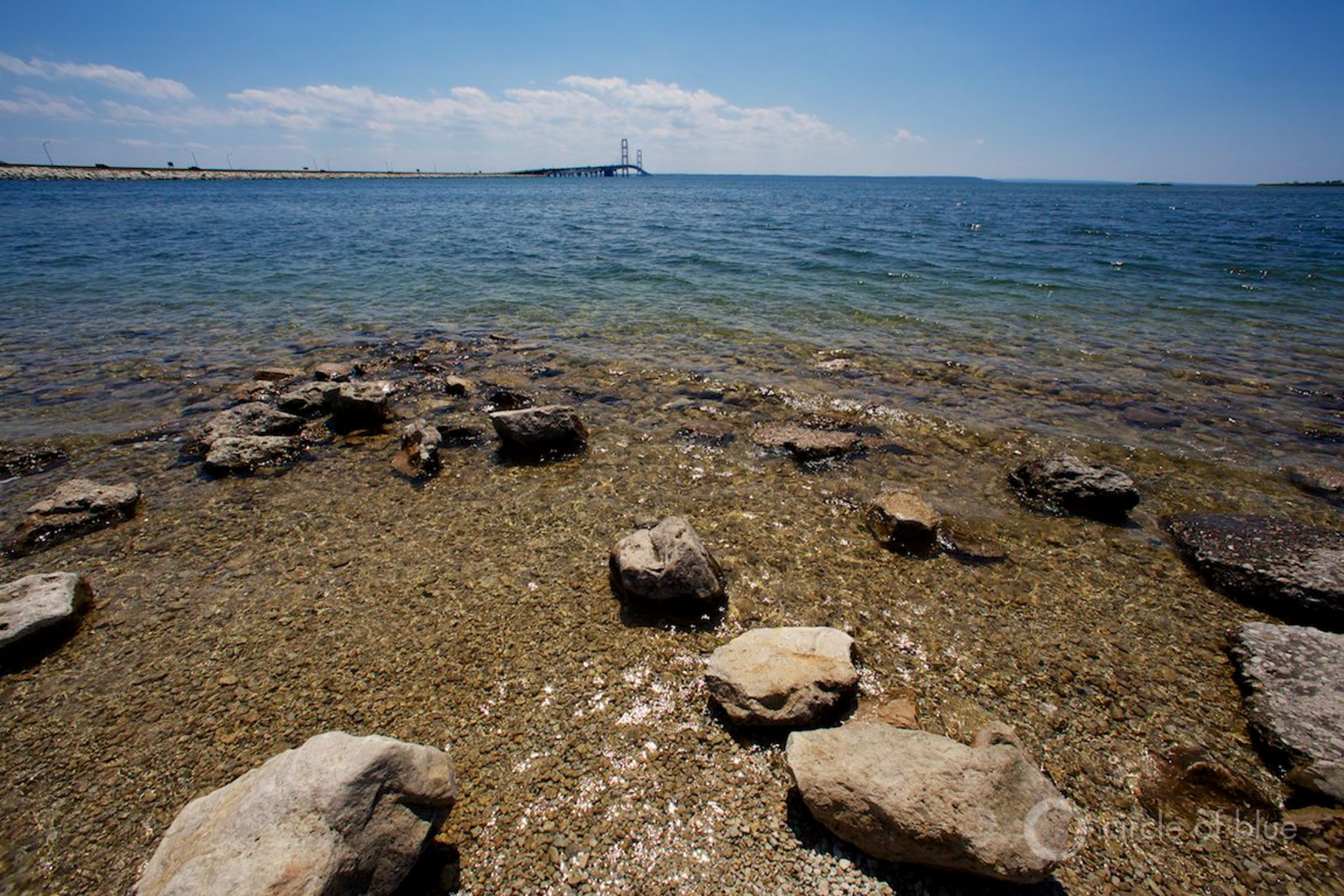
Studies have estimated that as many as 1,000 kilometers of Lake Michigan and Lake Huron shoreline are vulnerable to an oil spill from the Line 5 straits crossing, though Enbridge disputes those findings. Photo © J. Carl Ganter / Circle of Blue
4. Violating pipeline slats requirement. The 1953 easement stipulates that the outside of the pipeline should be protected by wooden slats that would protect it against abrasion and external stresses. The memorandum says wooden slats were not fitted around the entire circumference of the pipe when it was installed, violating the easement, and have since gone missing in some areas.
5. Violating minimum pipeline curvature requirement. Historic photographs of the pipelines’ installations show that sections of the pipe were allowed to sag beyond the specified limit, resulting in deformations, according to the memorandum.
6. Violating maximum unsupported span provision. Under the easement, the pipelines across the straits cannot be unsupported for a distance greater than 22.8 meters (75 feet). In July 2014, the state of Michigan issued Enbridge a notice that it was in violation of the easement’s requirement. While Enbridge installed more supports to comply with the standards, the memorandum argues that the fix “cannot remedy the decades of untold and unknown stress damage these pipelines have experienced” while unsupported.
7. Violating federal oil spill response law. The federal Oil Pollution Act requires pipeline operators to have a federally approved oil spill response plan. Because the Department of Transportation has not issued regulations for spill response plans for pipelines that cross inland waters, it is impossible for Enbridge’s spill response plan to be approved. Due to this technical violation of federal law, the Line 5 pipelines are also in violation of the easement, according to the memorandum.
When you look at a high risk, this is of the highest level.
— Jim Olson, president of FLOW
However, Enbridge asserts that its emergency response plan has been reviewed by the federal Pipeline and Hazardous Materials Safety Administration, as required by regulation, and that “there is no ‘approval requirement’ in federal regulations governing pipelines.” The company conducted a spill response drill in the straits in September 2015.
8. Violating Michigan Environmental Protection Act. Because of the above violation of federal law, the memorandum contends that the pipelines are also in violation of state law.
According to the easement, Enbridge would have a 90-day period to correct the violations after Michigan provided it with written notice. A failure to do so would allow the state to end the agreement.
“The state of Michigan has legal authority under the easement itself to terminate, to start the proceedings, to start that clock going because Enbridge is failing to comply with these eight provisions that we’ve outlined in our submission,” Liz Kirkwood, executive director of FLOW, told reporters. “They also have an independent cause for action under the Michigan Environmental Protection Act because of the substantial likelihood of harm and pollution. Enbridge does not have a federally approved oil spill response plan under [Department of Transportation] regulations. Finally, it is a violation of public trust common law, which could be another independent cause for the state of Michigan to bring.”
A news correspondent for Circle of Blue based out of Hawaii. She writes The Stream, Circle of Blue’s daily digest of international water news trends. Her interests include food security, ecology and the Great Lakes.
Contact Codi Kozacek

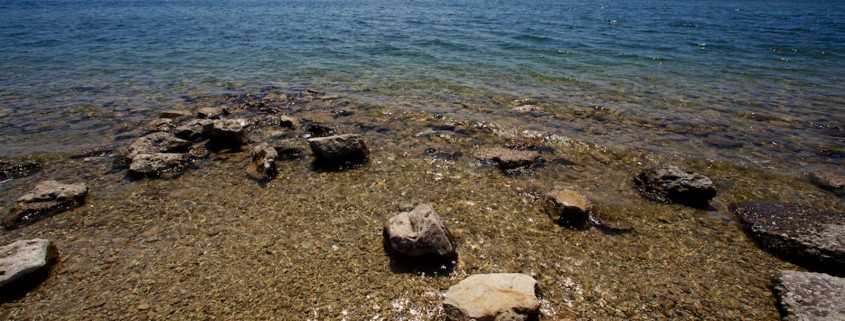

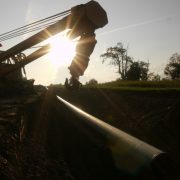

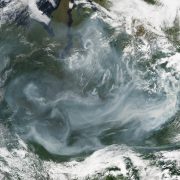
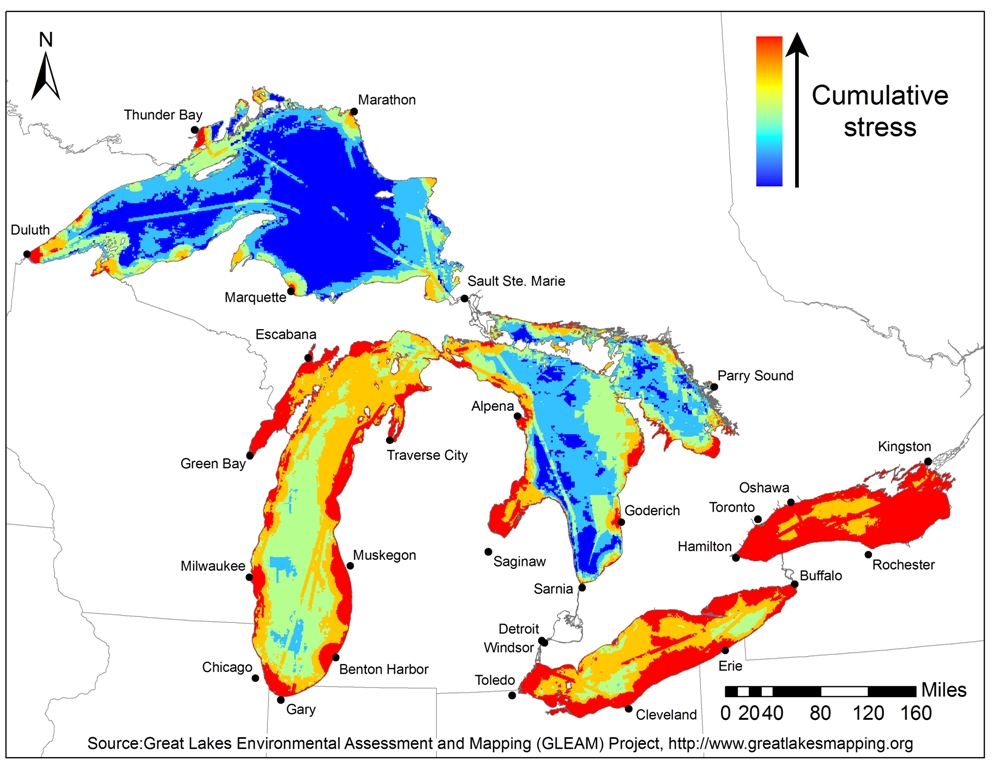

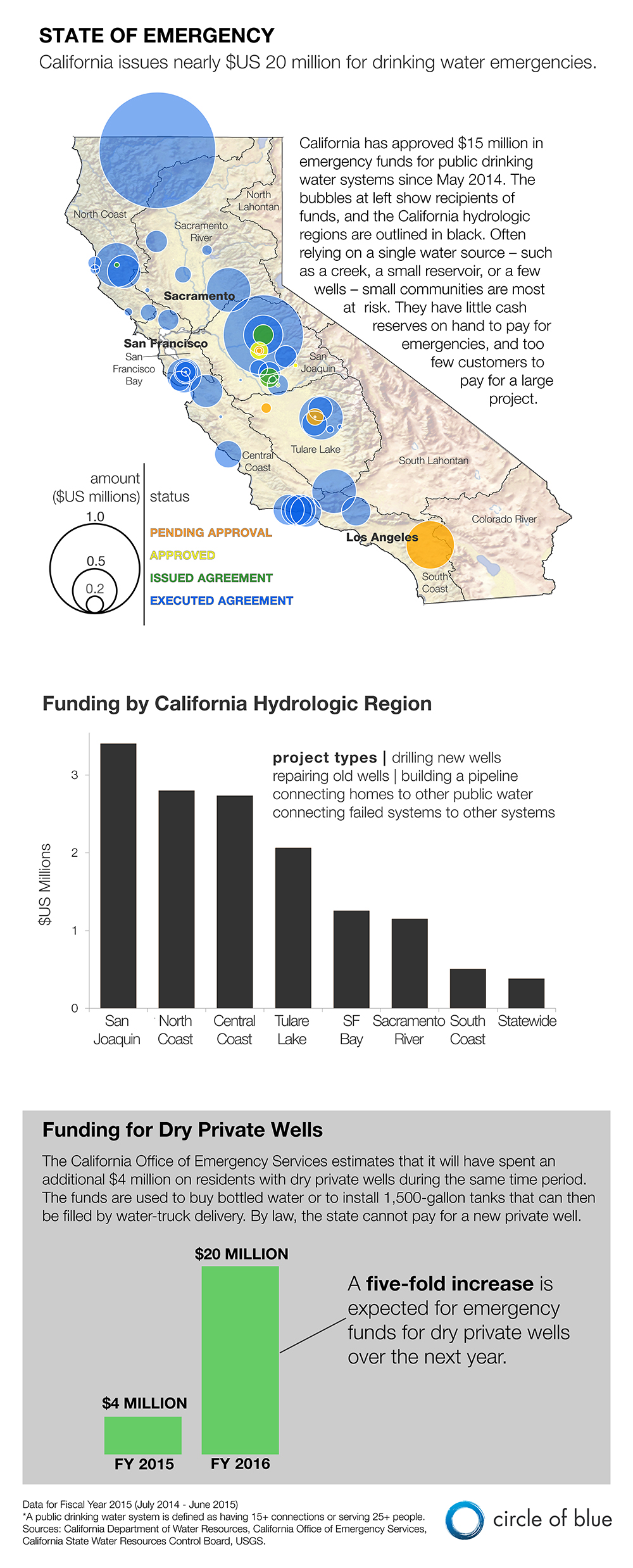


Leave a Reply
Want to join the discussion?Feel free to contribute!